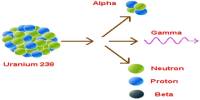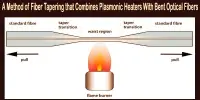Lithium-based scintillator crystals are materials that are used in radiation detection and imaging applications. These crystals are made from a combination of lithium and other elements, such as boron or indium that allow them to absorb radiation and produce light as a result.
Security concerns over radioactive materials have persisted for many years. Today, radiation detectors are commonly used in airports and other public areas, and nuclear regulators must be able to track the amounts of subatomic particles like neutrons.
Now, a team of researchers led by the University of Tsukuba has tested a new method of scintillation radiation detection based on wavelength information rather than waveform.
In a study published this month in Progress of Theoretical and Experimental Physics, researchers from the Faculty of Pure and Applied Sciences at the University of Tsukuba showed how to detect and distinguish between neutron and gamma-ray sources using data from scintillator emission wavelengths.
Often, detectors known as scintillators are used for this purpose. Similar to more well-known forms of glow-in-the-dark phenomena like fluorescence and phosphorescence, scintillation works on a physical level.
Our wavelength-based particle identification method is highly versatile and may be applied to other crystals and detector systems.
Professor Takashi Iida
In typical fluorescence, an electron in the material is excited by a UV photon, which causes it to lose some energy but re-emit the remainder as a visible photon. The incoming photon in scintillation is an X-ray or gamma ray, which has a significantly higher energy and is potent enough to totally remove the electron from the atom.
A UV or visible photon is released when the system finally relaxes, and other electronics can pick it up. On the basis of the pulse’s waveform, conventional scintillator detectors typically attempt to discriminate between neutrons and gamma rays.
“This older method typically resulted in incorrect readings due to the small variation in waveforms,” says Professor Takashi Iida, lead author of the study.
Instead, using information from the wavelength of the scintillation light in the new gadget, the researchers were able to categorize the radiation kind.
In this study, crystals containing the elements europium, lithium, calcium, and iodine (Eu:LiCaI) were produced with carefully controlled levels of impurities. A multi-pixel photon counter optical sensor was used to find the light produced in the scintillator.
On the basis of the output signal ratio of the detected light with and without long-wavelength filters used, a neutron source and a gamma-ray source could then be separated.
“Our wavelength-based particle identification method is highly versatile and may be applied to other crystals and detector systems,” says Professor Iida.
To increase the dependability of portable radiation monitoring systems, further investigations might optimize the ratio of elements in the crystal. This work can aid in the difficulties of finding nuclear materials and enhance the security of sensitive locations like airports and retail centers.
















